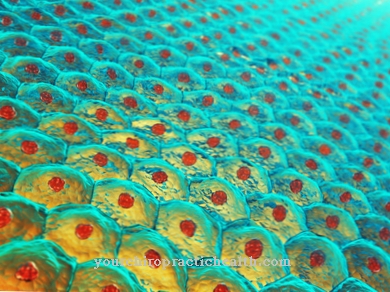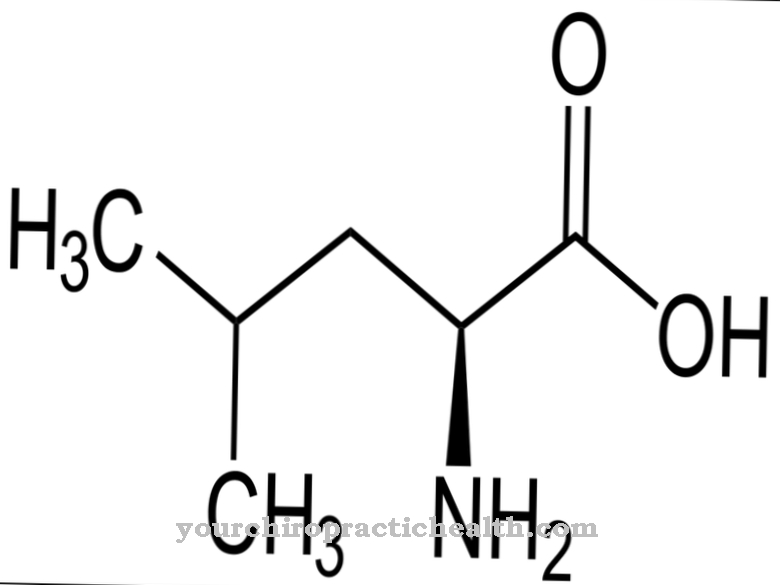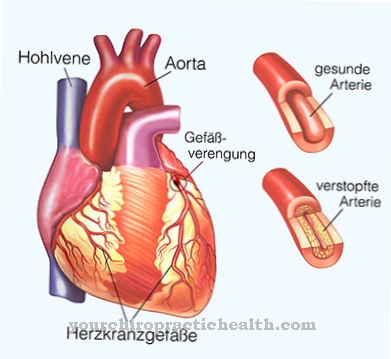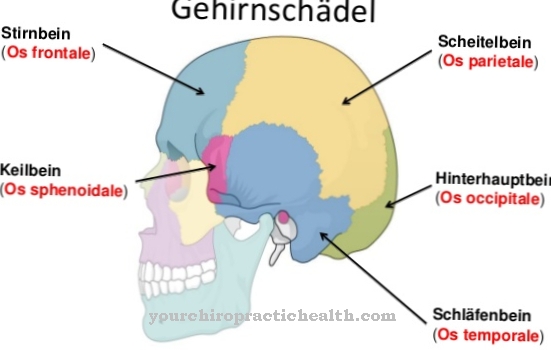Neurology understands by that Talosa Hunt Syndrome a special form of the cavernous sinus syndrome, which is characterized by the failure of various cranial nerves. In Tolosa Hunt syndrome, paralysis of the eye muscles is due to a granulomatous inflammation. The prognosis is favorable, but recurrences often occur.
What is Tolosa Hunt Syndrome?

© romaset - stock.adobe.com
The Tolosa Hunt Syndrome is a special form of the cavernous sinus syndrome that manifests itself in neurological deficits. The cavernous sinus is a venous blood conductor of the brain, in the side wall of which there are various cranial nerves. In cavernous sinus syndrome, there is a corresponding failure of the cranial nerves. The cranial nerves III, IV, VI, V1 and V2 are affected by compressions. The cause of these compressions can be a tumor as well as a septic or aseptic thrombosis.
Fistulas or trauma are just as often the cause of the syndrome. Tolosa Hunt syndrome is a final conceivable cause of cavernous sinus syndrome. The clinical symptoms of Tolosa-Hunt syndrome are largely similar to those of cavernous sinus syndrome and are causally related to it. Tolosa Hunt syndrome is a granulomatous inflammatory disease of the cavernous sinus that causes compression of the cranial nerves, thus producing the symptoms of cavernous sinus syndrome. Eduard Tolosa and William Edward Hunt first described the disease in the 20th century.
causes
The clinical symptoms of Tolosa-Hunt syndrome are characterized by granulomatous inflammation. This inflammation creates small, nodular accumulations of cells on the cavernous sinus, also known as granulomas. In the case of granulomatous inflammation, cell accumulations consisting of monocytes, macrophages and epithelial cells or [giant Langhans cells]] are present in the inflamed tissue.
Lymphocytes can also be in the inflamed area. Such inflammations are characteristic, for example, in the context of diseases such as tuberculosis, sarcoidosis, leprosy or syphilis. They correspond to either small-scaled epithelial cell reactions, granulomatous epithelial cell reactions, mixed-cell granulomas or histiocytic granulomas.
The aetiology of the granulomatous inflammation associated with Tolosa Hunt Syndrome has not yet been clarified. The syndrome may be caused by malignant diseases in individual cases. The disease affects adults almost exclusively. With 300 known cases, the syndrome is an extremely rare neurological eye disease.
Symptoms, ailments & signs
Tolosa Hunt syndrome causes sharp pain behind the eye that suddenly shoots into the structures. The inflammation also causes paralysis of the eye muscles. Parts of the oculomotor nerve as well as parts of the trochlear nerve and abducens nerve can be affected by the deficits. If the oculomotor nerve is affected, there may be an accommodation disorder of the eye.
The upper eyelid usually hangs down. In contrast, gaze deviation is characteristic of trochlear palsy. The eye rolls outward or deviates vertically. Double vision are characteristic of palsy of the abdomen. The affected eye hangs behind the healthy eye when looking to the side. In Tolosa-Hunt syndrome, the individual pareses are usually present at the same time.
The result is an ophthalmoplegia, that is, a comprehensive paralysis of the external or internal eye muscles. The pre-orbital pain in the eye is considered an early symptom. Symptoms of paralysis only appear later.Often the symptoms resolve on their own within eight weeks.
Diagnosis & course of disease
The diagnosis of Tolosa-Hunt syndrome is made via a functional test of the cranial nerves and the neurological findings collected. A visual assessment also takes place. The inflammatory cause is proven by laboratory tests using inflammation diagnostics. Malignant diseases must be ruled out using imaging diagnostics.
Regular checks are also useful in the further course in order to identify any degeneracy early enough. The prognosis for Tolosa-Hunt syndrome is considered favorable. Permanent paralysis of the eyes does not usually occur. The symptoms usually resolve quickly. Even so, painful recurrences can occur in the future.
Complications
As a rule, Tolosa-Hunt syndrome leads to severe visual problems. In the worst case, this can lead to complete blindness of the person concerned. Especially in young people, blindness can lead to severe psychological complaints or depression. The muscles in the eyes in particular are paralyzed in Tolosa Hunt syndrome, so that those affected can no longer move or close their eyes.
This can also lead to disturbances in the sleep rhythm. The eye itself cannot be held properly and rolls off. Furthermore, pain in the eyes often occurs, which can spread to the ears or head. In many cases, the symptoms are not permanent. In addition, the Tolosa Hunt Syndrome can also heal spontaneously.
Tolosa Hunt Syndrome is usually treated with the help of eye drops and can significantly alleviate the symptoms. This also prevents complete blindness. However, a positive course of the disease cannot be fully predicted. However, the life expectancy of the patient is not negatively influenced by illness.
When should you go to the doctor?
As a rule, those affected with Tolosa Hunt syndrome need medical treatment to prevent further complications or symptoms. Self-healing cannot occur, so that the person concerned always has to see a doctor. The earlier the doctor is consulted for Tolosa Hunt syndrome, the better the further course of this disease is usually.
See a doctor for Tolosa Hunt Syndrome if the person has sudden eye discomfort. As a rule, a drooping eye occurs, which does not go away on its own. Furthermore, paralysis of the eye muscles can indicate Tolosa Hunt syndrome and should also be examined by a doctor. In some cases, the symptoms resolve on their own after a few weeks, although a doctor should still check them out.
For Tolosa Hunt syndrome, it is usually necessary to see an ophthalmologist. The further course depends very much on the exact severity of the symptoms, so that no general course can be given.
Treatment & Therapy
Tolosa Hunt syndrome is treated symptomatically. Since the cause has not yet been conclusively clarified, there are no causal therapies so far. Symptomatic treatment usually does not take place with eye drops, but focuses on intravenous medication. High-dose corticosteroids are administered to the patient. All corticosteroids act as lipophilic hormones on the receptors in the cytosol and cell nuclei.
The active ingredient diffuses freely through the cell membrane and thus reaches the relevant structures. Meanwhile, medicine suspects that corticoids also have an effect on membrane-bound receptors. The receptors inside the cell can be divided into two different types. The first type is specific to mineral corticoids. The second type, on the other hand, reacts to glucocorticoids. The specificity of all internal receptors presumably depends on the 11beta-hydroxysteroid dehydrogenase-1 activity, in which dehydration of the ß-OH group takes place.
Usually, symptoms of Tolosa Hunt syndrome resolve after three to five days of intravenous corticosteroid administration. In individual cases, eye muscle disorders persist. If this is the case, eye movement therapy can be used in addition to drug therapy. Ideally, the cranial nerve paralysis can be reversed through targeted training.
The cranial nerves are reactivated under certain circumstances or the patients at least learn to compensate for strategies that improve their quality of life. If the symptoms recur, the patients benefit from corticosteroid treatment as early as possible, since at best this prevents symptoms of paralysis again.
You can find your medication here
➔ Medicines for eye infectionsprevention
The etiology of Tolosa-Hunt syndrome is so far unknown. For this reason, no meaningful preventive measures to avoid the disease are available so far.
Aftercare
The Tolosa-Hunt syndrome is characterized by a pronounced pain sensation in the eye and symptoms of paralysis. Occasionally, neurological complaints such as dizziness are added. The person affected often perceives the symptoms as very stressful. The symptoms are triggered by an inflammation in the eye socket.
In some cases they resolve on their own and heal without therapy. Nevertheless, follow-up care is recommended in order to accompany the healing process medically. It aims to completely cure the syndrome without any long-term effects. A recurrence of the eye disease should be prevented. Before starting therapy, a differential diagnosis is made, as different triggers are possible for the symptoms.
It may be necessary to take a tissue sample for clarification. As part of aftercare, the paralysis must be prevented from spreading to areas of the brain. Treatment and follow-up procedures are carried out by an ophthalmologist. The inflammation is fought with the help of medication. The specialist checks the healing progress, if necessary he varies the dosage or prescribes additional painkillers for the patient.
Follow-up care lasts until the time of healing. Even if the patient remains symptom-free, he should attend an ophthalmological check-up. In this way, recurring symptoms can be identified early.
You can do that yourself
In the case of this disease, self-help measures are by no means a substitute for medical therapy, but they can be used as support in parallel to treatment.
Since the cause of Tolosa-Hunt syndrome is unknown, self-therapy focuses on relieving the pain caused by the inflammatory processes in the area behind the eye sockets. Painkillers, which also have anti-inflammatory effects, help against these in acute cases: These include ibuprofen, diclofenac and ASA (aspirin). Violent, jerky movements of the head and tension caused by lifting and carrying loads, for example, should be avoided as far as possible so that the inflamed tissue is not additionally irritated.
Even if the eyes themselves are not affected by this disease, reducing the brightness and cooling the forehead, for example with a damp washcloth, can help to cope with the headache. Since rest and rest are also important for the healing process, those affected should lie as calmly as possible until the medication has an effect and the pain subsides.
In the long term, attempts should be made to switch off inflammatory factors in everyday life, for example by changing diet or avoiding stress. This can also help to prevent the disease from recurring as much as possible or to lessen it as it progresses.


.jpg)
.jpg)
.jpg)
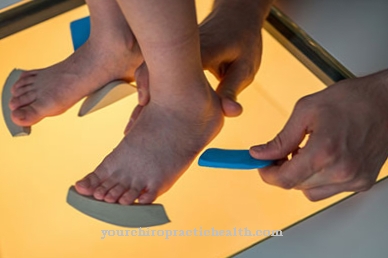


.jpg)
